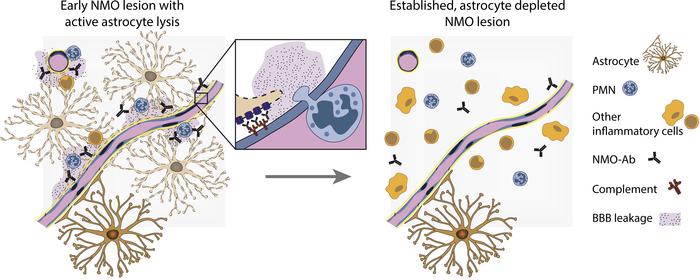Citation Information: J Clin Invest. 2021;131(5):e141694. https://doi.org/10.1172/JCI141694.
Blood-brain barrier resealing in neuromyelitis optica occurs independently of astrocyte regeneration
Abstract
Approximately 80% of neuromyelitis optica spectrum disorder (NMOSD) patients harbor serum anti–aquaporin-4 autoantibodies targeting astrocytes in the CNS. Crucial for NMOSD lesion initiation is disruption of the blood-brain barrier (BBB), which allows the entrance of Abs and serum complement into the CNS and which is a target for new NMOSD therapies. Astrocytes have important functions in BBB maintenance; however, the influence of their loss and the role of immune cell infiltration on BBB permeability in NMOSD have not yet been investigated. Using an experimental model of targeted NMOSD lesions in rats, we demonstrate that astrocyte destruction coincides with a transient disruption of the BBB and a selective loss of occludin from tight junctions. It is noteworthy that BBB integrity is reestablished before astrocytes repopulate. Rather than persistent astrocyte loss, polymorphonuclear leukocytes (PMNs) are the main mediators of BBB disruption, and their depletion preserves BBB integrity and prevents astrocyte loss. Inhibition of PMN chemoattraction, activation, and proteolytic function reduces lesion size. In summary, our data support a crucial role for PMNs in BBB disruption and NMOSD lesion development, rendering their recruitment and activation promising therapeutic targets.
Authors
Anne Winkler, Claudia Wrzos, Michael Haberl, Marie-Theres Weil, Ming Gao, Wiebke Möbius, Francesca Odoardi, Dietmar R. Thal, Mayland Chang, Ghislain Opdenakker, Jeffrey L. Bennett, Stefan Nessler, Christine Stadelmann
Graphical abstract



Copyright © 2025 American Society for Clinical Investigation
ISSN: 0021-9738 (print), 1558-8238 (online)

